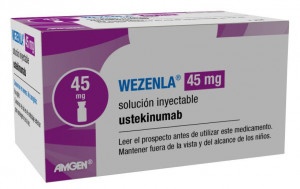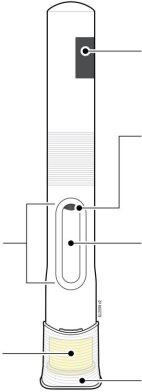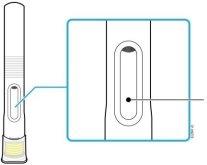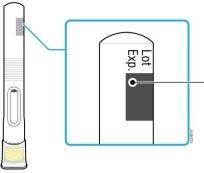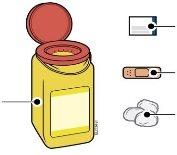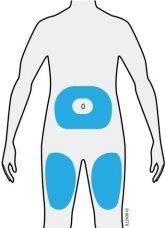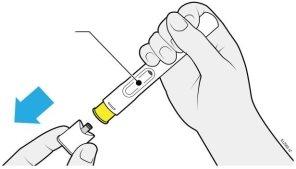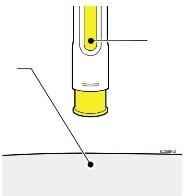
How to use WEZENLA 45 mg SOLUTION FOR INJECTION IN A PRE-FILLED PEN
Introduction
Package Leaflet: Information for the Patient
WEZENLA 45 mg solution for injection in pre-filled pen
WEZENLA 90 mg solution for injection in pre-filled pen
ustekinumab
This medicine is subject to additional monitoring, which will allow for quick identification of new safety information. You can help by reporting any side effects you may get. The last section of the leaflet includes information on how to report side effects.
Read all of this leaflet carefully before you start using this medicine, because it contains important information for you.
This leaflet has been written for the person taking the medicine.
- Keep this leaflet, you may need to read it again.
- If you have any further questions, ask your doctor or pharmacist.
- This medicine has been prescribed for you only. Do not pass it on to others. It may harm them, even if their signs of illness are the same as yours.
- If you get any side effects, talk to your doctor or pharmacist. This includes any possible side effects not listed in this leaflet. See section 4.
Contents of the pack
- What is WEZENLA and what is it used for
- What you need to know before you use WEZENLA
- How to use WEZENLA
- Possible side effects
- Storage of WEZENLA
- Contents of the pack and other information
1. What is WEZENLA and what is it used for
What is WEZENLA
WEZENLA contains the active substance “ustekinumab”, a monoclonal antibody. Monoclonal antibodies are proteins that identify and bind specifically to certain proteins in the body.
WEZENLA belongs to a group of medicines called “immunosuppressants”. These medicines work by weakening part of the immune system.
What is WEZENLA used for
WEZENLA is used to treat the following inflammatory diseases:
- Plaque psoriasis - in adults
- Psoriatic arthritis - in adults
- Moderate to severe Crohn's disease - in adults
Plaque psoriasis
Plaque psoriasis is a skin disease that causes inflammation affecting the skin and nails. WEZENLA reduces inflammation and other signs of the disease.
WEZENLA is used in adults with moderate to severe plaque psoriasis who are unable to tolerate phototherapy or other systemic therapies or when these treatments do not work.
Psoriatic arthritis
Psoriatic arthritis is an inflammatory disease of the joints, usually accompanied by psoriasis. If you have active psoriatic arthritis, you will first receive other medicines. If you do not respond well to these medicines, you may be treated with WEZENLA to:
- Reduce the signs and symptoms of your disease.
- Improve your physical function.
- Reduce damage to your joints.
Crohn's disease
Crohn's disease is an inflammatory disease of the intestine. If you have Crohn's disease, you will first be given other medicines. If you do not respond adequately or do not tolerate these medicines, you may be given WEZENLA to reduce the signs and symptoms of your disease.
2. What you need to know before you use WEZENLA
Do not use WEZENLA
- If you are allergic to ustekinumabor to any of the other ingredients of this medicine (listed in section 6).
- If you have an active infectionthat your doctor thinks is important.
If you are not sure if any of the above applies to you, talk to your doctor or pharmacist before using WEZENLA.
Warnings and precautions
Talk to your doctor or pharmacist before you start using WEZENLA. Your doctor will check how you are before each treatment. Make sure you tell your doctor about any illness you have before each treatment. Your doctor will also ask you if you have recently been near someone who may have tuberculosis. Your doctor will examine you and do a test to detect tuberculosis before you use WEZENLA. If your doctor thinks you are at risk of tuberculosis, they may give you medicines to treat it.
Observe serious side effects
WEZENLA may cause serious side effects, including allergic reactions and infections. You should be aware of certain signs of illness while you are using WEZENLA. See the complete list of these side effects in “Serious side effects” in section 4.
Before using WEZENLA, tell your doctor:
- If you have ever had an allergic reaction to ustekinumab.Talk to your doctor if you are not sure.
- If you have ever had any type of cancer– this is because immunosuppressants like WEZENLA weaken part of the immune system. This may increase the risk of having cancer.
- If you have received treatment for psoriasis with other biologics (a medicine produced from a biological source and usually given by injection)– the risk of having cancer may be higher.
- If you have had a recent infection.
- If you have any new or changing lesionswithin the area of psoriasis or on intact skin.
- If you are taking any other treatment for psoriasis and/or psoriatic arthritis– such as any other immunosuppressant or phototherapy (when your body is treated with a type of ultraviolet light (UV)). These treatments may also weaken part of the immune system. The use of these treatments in combination with WEZENLA has not been studied. However, it may increase the likelihood of suffering from diseases related to a weaker immune system.
- If you have received allergy shots– it is not known if WEZENLA can affect these treatments.
- If you are 65 years of age or older– you are more likely to get infections.
If you are not sure if you have any of these conditions, talk to your doctor or pharmacist before using WEZENLA.
Some patients have experienced lupus-like reactions during treatment with ustekinumab, including cutaneous lupus or lupus-like syndrome. Talk to your doctor immediately if you experience a red, raised, and scaly skin rash, sometimes with a darker border, in areas of the skin exposed to the sun or if they are accompanied by joint pain.
Heart attacks and strokes
In a study in patients with psoriasis treated with ustekinumab, heart attacks and strokes have been observed. Your doctor will periodically check your risk factors for heart disease and stroke to ensure they are being treated properly. Seek medical attention immediately if you experience chest pain, weakness, or unusual sensation on one side of the body, facial paralysis, or abnormalities in speech or vision.
Children and adolescents
WEZENLA pre-filled pen is not recommended for use in children and adolescents under 18 years of age with psoriasis, as it has not been studied in this age group. For children from 6 years and adolescents with psoriasis, the pre-filled syringe or vial should be used instead.
WEZENLA is not recommended for use in children and adolescents under 18 years of age with psoriatic arthritis or Crohn's disease, as it has not been studied in this age group.
Using WEZENLA with other medicines, vaccines
Tell your doctor or pharmacist:
- If you are using, have recently used, or might use other medicines.
- If you have been vaccinated recently or are going to have a vaccination.Certain types of vaccines (live vaccines) should not be given while you are using WEZENLA.
- If you received WEZENLA during pregnancy, inform your baby's doctor about your treatment with WEZENLA before your baby receives any vaccination, including live vaccines such as the BCG vaccine (used to prevent tuberculosis).Live vaccines are not recommended for your baby in the first 12 months after birth if you received WEZENLA during pregnancy, unless your baby's doctor recommends otherwise.
Pregnancy and breastfeeding
- If you are pregnant, think you may be pregnant, or are planning to have a baby, ask your doctor for advice before taking this medicine.
- No increased risk of birth defects has been seen in babies exposed to WEZENLA in the womb.However, there is limited experience with WEZENLA in pregnant women. Therefore, it is preferable to avoid the use of WEZENLA during pregnancy.
- If you are a woman of childbearing age, you are advised to avoid becoming pregnant and to use adequate contraception while using WEZENLA and for at least 15 weeks after the last treatment with WEZENLA.
- WEZENLA may pass into the placenta to the fetus.If you received WEZENLA during pregnancy, your baby may have a higher risk of getting an infection.
- It is important that you inform your baby's doctors and other healthcare professionals if you received WEZENLA during your pregnancy before your baby receives any vaccination.Live vaccines, such as the BCG vaccine (used to prevent tuberculosis), are not recommended for your baby in the first 12 months after birth if you received WEZENLA during pregnancy, unless your baby's doctor recommends otherwise.
- Ustekinumab may be excreted in breast milk in very small amounts.If you are breastfeeding or plan to breastfeed, tell your doctor. You and your doctor will decide whether you should breastfeed or use WEZENLA. You should not do both.
Driving and using machines
WEZENLA has no or negligible influence on the ability to drive and use machines.
3. How to use WEZENLA
WEZENLA should be used under the guidance and supervision of a doctor with experience in the treatment of the conditions for which WEZENLA is indicated.
Always follow exactly the administration instructions of this medicine given by your doctor. If you are not sure, ask your doctor. Ask your doctor when you should have the injections and about follow-up appointments.
How much WEZENLA is given
Your doctor will decide how much WEZENLA you need to use and the duration of treatment.
Adults from 18 years of age
Psoriasis or psoriatic arthritis
- The recommended starting dose is 45 mg of WEZENLA.Patients who weigh more than 100 kilograms (kg) may start with a dose of 90 mg instead of 45 mg.
- After the initial dose, you will receive the next dose 4 weeks later and then every 12 weeks.The following doses are usually the same as the starting dose.
Crohn's disease
- During treatment, your doctor will give you the first dose of approximately 6 mg/kg of WEZENLA through a drip in a vein in your arm (intravenous infusion).After the initial dose, you will receive the next dose of 90 mg of WEZENLA 8 weeks later and then every 12 weeks, through an injection under the skin (“subcutaneously”).
- In some patients, after the first injection under the skin, 90 mg of WEZENLA will be given every 8 weeks.Your doctor will decide when you should receive the next dose.
How WEZENLA is given
- WEZENLA is given through an injection under the skin (“subcutaneously”).At the start of your treatment, medical staff may inject WEZENLA for you.
- However, you and your doctor may decide that you inject WEZENLA yourself.In that case, you will be trained on how to inject WEZENLA yourself.
- For instructions on how to inject WEZENLA, see “Instructions for use” at the end of this leaflet.
Talk to your doctor if you have any questions about how to self-inject.
If you use more WEZENLA than you should
If you have used or been given too much WEZENLA, talk to your doctor or pharmacist immediately. Always carry the medicine box with you, even if it is empty.
If you forget to use WEZENLA
If you miss a dose, talk to your doctor or pharmacist. Do not take a double dose to make up for forgotten doses.
If you stop using WEZENLA
Stopping WEZENLA is not dangerous. However, if you stop using it, your symptoms may come back.
If you have any other questions about the use of this medicine, ask your doctor or pharmacist.
4. Possible Adverse Effects
Like all medicines, this medicine may cause adverse effects, although not all people suffer from them.
Severe Adverse Effects
Some patients may have severe adverse effects that may require urgent treatment.
Allergic Reactions – these may require urgent treatment. Contact your doctor or get emergency medical help immediately if you notice any of the following signs.
- Severe allergic reactions ("anaphylaxis") are rare in the population using ustekinumab (may affect up to 1 in 1,000 people). The signs include:
- difficulty breathing and swallowing
- low blood pressure, which can cause dizziness or mild headaches
- swelling of the face, lips, mouth, or throat.
- Common signs of an allergic reaction include skin rash and hives (these may affect up to 1 in 100 people).
In rare cases, allergic reactions at the lung level and lung inflammation have been reported in patients treated with ustekinumab. Inform your doctor immediately if you have symptoms such as cough, difficulty breathing, and fever.
If you have a severe allergic reaction, your doctor may decide that you should not use WEZENLA again.
Infections – these may require urgent treatment. Contact your doctor immediately if you notice any of these signs.
- Nose or throat infections and the common cold are frequent (may affect up to 1 in 10 people)
- Chest infections are uncommon (may affect up to 1 in 100 people)
- Inflammation of the tissues under the skin ("cellulitis") is uncommon (may affect up to 1 in 100 people)
- Herpes (a type of painful rash with blisters) is uncommon (may affect up to 1 in 100 people)
WEZENLA may affect your ability to fight infections. Some of them could become serious and be caused by viruses, fungi, bacteria (including tuberculosis), or parasites, and include infections that occur mainly in people with a weakened immune system (opportunistic infections). Opportunistic infections of the brain (encephalitis, meningitis), lungs, and eyes have been reported in patients receiving treatment with ustekinumab.
You should watch for signs of infection while using WEZENLA. These include:
- fever, flu-like symptoms, night sweats, weight loss
- feeling tired or having difficulty breathing; cough that does not go away
- having hot, red, and painful skin or having a painful skin rash with blisters
- burning when urinating
- diarrhea
- visual impairment or loss of vision
- headache, neck stiffness, photosensitivity, nausea, or confusion.
Communicate with your doctor immediately if you notice any of these signs of infection, as they may be signs of infections such as chest infections, skin infections, herpes, or opportunistic infections that could have serious complications. You should also inform your doctor if you have any type of infection that does not go away or comes back. Your doctor may decide that you should not use WEZENLA until the infection goes away. Also, contact your doctor if you have any open cuts or ulcers that could become infected.
Skin Shedding – increased redness and skin shedding over a large area of the body may be symptoms of erythrodermic psoriasis or exfoliative dermatitis, which are serious skin disorders. If you notice any of these symptoms, you should inform your doctor immediately.
Other Adverse Effects
Frequent Adverse Effects(may affect up to 1 in 10 people):
- Diarrhea
- Nausea
- Vomiting
- Feeling tired
- Feeling dizzy
- Headache
- Itching ("pruritus")
- Back, muscle, or joint pain
- Sore throat
- Redness and pain at the injection site
- Sinusitis
Uncommon Adverse Effects(may affect up to 1 in 100 people):
- Dental infections
- Vaginal yeast infections
- Depression
- Nasal congestion or stuffiness
- Bleeding, bruising, hardening, swelling, and itching at the injection site
- Feeling weak
- Drooping eyelid and sinking of the muscles on one side of the face ("facial paralysis" or "Bell's palsy"), which is usually temporary
- A change in psoriasis with redness and new small, yellow, or white skin blisters, sometimes accompanied by fever (pustular psoriasis)
- Skin peeling (skin exfoliation)
- Acne
Rare Adverse Effects(may affect up to 1 in 1,000 people):
- Redness and skin shedding over a large area of the body, which may cause itching or pain (exfoliative dermatitis). Similar symptoms may develop as a natural change in psoriasis symptoms (erythrodermic psoriasis)
- Inflammation of small blood vessels, which may cause a skin rash with small red or purple bumps, fever, or joint pain (vasculitis)
Very Rare Adverse Effects(may affect up to 1 in 10,000 people):
- Blisters on the skin, which may be red and cause itching and pain (bullous pemphigoid)
- Cutaneous lupus or lupus-like syndrome (red, raised, and scaly skin rash in sun-exposed areas, possibly accompanied by joint pain).
Reporting Adverse Effects
If you experience any type of adverse effect, consult your doctor or pharmacist, even if it is a possible adverse effect that is not listed in this prospectus. You can also report them directly through the national reporting system included in Appendix V. By reporting adverse effects, you can contribute to providing more information on the safety of this medicine.
5. Storage of WEZENLA
- Keep this medicine out of the sight and reach of children.
- Store in a refrigerator (between 2 °C and 8 °C). Do not freeze.
- Keep the preloaded pen in the outer packaging to protect it from light.
- If necessary, individual preloaded WEZENLA pens can also be stored at room temperature up to 30°C for a maximum single period of up to 30 days in their original box to protect them from light. Note the date when the preloaded pen is first removed from the refrigerator and the date when it must be discarded. The discard date must not exceed the original expiration date printed on the box. Once a preloaded pen has been stored at room temperature (up to a maximum of 30°C), it must not be stored in the refrigerator again. Discard the preloaded pen if it is not used within 30 days of storage at room temperature or from the original expiration date, whichever comes first.
- Do not shake WEZENLA preloaded pens. Prolonged vigorous shaking may damage the product.
Do not use this medicine:
- After the expiration date stated on the label and carton after "CAD" or "EXP". The expiration date is the last day of the month indicated.
- If the liquid changes color, is cloudy, or has foreign particles floating in it (see section 6 "Appearance of WEZENLA and package contents").
- If you know or believe that it has been exposed to extreme temperatures (such as accidental heating or freezing).
- If the product has been vigorously shaken.
WEZENLA is for single use. You must discard any unused product remaining in the preloaded pen. Medicines should not be disposed of through wastewater or household waste. Ask your pharmacist how to dispose of the packaging and medicines you no longer need. This will help protect the environment.
6. Container Contents and Additional Information
Composition of WEZENLA
- The active ingredient is ustekinumab. Each pre-filled pen contains 45 mg of ustekinumab in 0.5 ml or 90 mg of ustekinumab in 1 ml.
- The other components are L-histidine, L-histidine monohydrate hydrochloride, polysorbate 80, sucrose, and water for injectable preparations.
Appearance of WEZENLA and Container Contents
WEZENLA is a clear to opalescent injectable solution, colorless to light yellow. It is presented in a container containing 1 pre-filled pen of 1 ml glass. Each pre-filled pen contains 45 mg of ustekinumab in 0.5 ml or 90 mg of ustekinumab in 1 ml of injectable solution.
Marketing Authorization Holder and Manufacturer
Amgen Technology (Ireland) UC,
Pottery Road,
Dun Laoghaire,
Co Dublin,
Ireland
Marketing Authorization Holder
Amgen Technology (Ireland) UC,
Pottery Road,
Dun Laoghaire,
Co Dublin,
Ireland
Manufacturer
Amgen NV
Telecomlaan 5-7
1831 Diegem
Belgium
You can request more information about this medication by contacting the local representative of the marketing authorization holder:
België/Belgique/Belgien s.a. Amgen n.v. Tél/Tel: +32 (0)2 7752711 | Lietuva Amgen Switzerland AG Vilniaus filialas Tel: +370 5 219 7474 |
| Luxembourg/Luxemburg s.a. Amgen Belgique/Belgien Tél/Tel: +32 (0)2 7752711 |
Ceská republika Amgen s.r.o. Tel: +420 221 773 500 | Magyarország Amgen Kft. Tel.: +36 1 35 44 700 |
Danmark Amgen, filial af Amgen AB, Sverige Tlf.: +45 39617500 | Malta Amgen S.r.l. Italy Tel: +39 02 6241121 |
Deutschland Amgen GmbH Tel: +49 89 1490960 | Nederland Amgen B.V. Tel: +31 (0)76 5732500 |
Eesti Amgen Switzerland AG Vilniaus filialas Tel: +372 586 09553 | Norge Amgen AB Tlf: +47 23308000 |
Ελλάδα Amgen Ελλάς Φαρμακευτική Ε.Π.Ε. Τηλ: +30 210 3447000 | Österreich Amgen GmbH Tel: +43 (0)1 50 217 |
España Amgen S.A. Tel: +34 93 600 18 60 | Polska Amgen Biotechnologia Sp. z o.o. Tel.: +48 22 581 3000 |
France Amgen S.A.S. Tél: +33 (0)9 69 363 363 | Portugal Amgen Biofarmacêutica, Lda. Tel: +351 21 4220606 |
Hrvatska Amgen d.o.o. Tel: +385 (0)1 562 57 20 | România Amgen România SRL Tel: +4021 527 3000 |
Ireland Amgen Ireland Limited Tel: +353 1 8527400 | Slovenija AMGEN zdravila d.o.o. Tel: +386 (0)1 585 1767 |
Ísland Vistor hf. Sími: +354 535 7000 | Slovenská republika Amgen Slovakia s.r.o. Tel: +421 2 321 114 49 |
Italia Amgen S.r.l. Tel: +39 02 6241121 | Suomi/Finland Amgen AB, sivuliike Suomessa/Amgen AB, filial i Finland Puh/Tel: +358 (0)9 54900500 |
Kύπρος C.A. Papaellinas Ltd Τηλ: +357 22741 741 | Sverige Amgen AB Tel: +46 (0)8 6951100 |
Latvija Amgen Switzerland AG Rigas filiale Tel: +371 257 25888 |
Date of Last Revision of this Leaflet
Other Sources of Information
Detailed information on this medication is available on the European Medicines Agency website: https://www.ema.europa.eu.
-------------------------------------------------------------------------------------------------------------------------
INSTRUCTIONS FOR USE
These "Instructions for Use" contain information on how to inject WEZENLA with a pre-filled pen (ConfiPen).
This pre-filled pen administers WEZENLA via a subcutaneous injection. Refer to the package leaflet for information on the medication.
Parts of the Pre-filled Pen
| Expiry Date | |
Plunger (may be visible in the window; location may vary | ||
Window | Medication | |
Yellow safety protector under the cap (needle inside) | Cap |
Important Information to Know Before Injecting WEZENLA |
Dose:
- WEZENLA is available in two different doses: 45 mg/0.5 ml and 90 mg/1.0 ml. Check your prescription to ensure you have the correct dose.
- The color of the label and the size of the pre-filled pen's window are different for each dose. The amount of medication in the pre-filled pen is also different for each dose.
|
|
45 mg/0.5 ml | 90 mg/1.0 ml |
Import:
|
Using the WEZENLA Pre-filled Pen:
- It is essential that you or your caregiver do not attempt to administer the injection unless you have received training from your doctor or a healthcare professional.
- Do notuse the pre-filled pen if the box is damaged or the seal is broken.
- Do notuse the pre-filled pen past the expiry date shown on the label.
- Do notshake the pre-filled pen.
- Do notremove the cap from the pre-filled pen until you are ready to perform the injection.
- Do notuse the pre-filled pen if it has been frozen.
- Do notuse the pre-filled pen if it has been dropped onto a hard surface. Although it may not be visible to the naked eye, some parts of the pre-filled pen may be broken. Use a new pre-filled pen, if available, and contact your doctor or healthcare professional.
Important:Keep the pre-filled pen and the sharps container out of the sight and reach of children. |
Preparation for WEZENLA Injection |
- Wait 30 minutes for the pre-filled pen to reach room temperature.
WAIT
30
minutes
- Remove the required number of pre-filled pens from the refrigerator.
- Let the pre-filled pen come to room temperature on its own.
- Do notwarm the pre-filled pen with hot water, in a microwave, or in direct sunlight.
- Do notput the pre-filled pen back in the refrigerator once it has reached room temperature.
- Do notshake the pre-filled pen at any time.
- The injection will be less painful and ensure the full dose is administered if the pre-filled pen is used at room temperature.
| Medication |
- Inspect the medication. It should be a clear to opalescent solution, colorless to light yellow.
- It is normal to see air bubbles.
- Do notuse WEZENLA if the medication is frozen, cloudy, discolored, or contains foreign particles.
| Expiry Date |
- Check the expiry date (EXP) and inspect the pre-filled pen for damage.
- Do notuse the pre-filled pen if the expiry date has passed.
- Do notuse the pre-filled pen if:
- the cap is missing or loose,
- it has cracks or broken parts, or
- it has been dropped onto a hard surface.
- Make sure you have the correct medication and dose.
Preparation for WEZENLA Injection |
| Alcohol swab | |
Sharps container | Antiseptic wipe Cotton ball or gauze |
- Gather the following necessary items for the injection and place them on a flat, clean, and well-lit surface:
- WEZENLA pre-filled pen (at room temperature),
- sharps container,
- alcohol swab,
- antiseptic wipe, and
- cotton ball or gauze.
| Abdomen Thigh |
- Choose one of these injection sites.
- Choose between the front of the thigh or the abdomen (except within 5 cm of the navel).
- Someone else can inject the injection into the thigh or abdomen for you.
Important:Avoid areas with scars, stretch marks, and bruises, areas that are painful to the touch, and areas where the skin is red or hardened. If possible, do not use areas of the skin with signs of psoriasis. |
- Wash your hands well with soap and water.
- Clean the injection site with an alcohol swab.
- Let the skin dry on its own.
- Do nottouch this area again before the injection.
WEZENLA Injection |
Important:Remove the cap only when you are ready for the injection (within 5 minutes), as the medication may dry out. Do notreplace the cap. |
Window should be visible |
|
- Hold the pre-filled pen so that you can see the window. Pull the cap straight off. Turning the cap may help to remove it.
- Do notput the cap back on, as this could damage the needle.
- It is normal to see a drop of medication at the end of the needle or in the yellow safety protector.
Important:Do not touch or press the yellow safety protector. Do not put your finger inside the yellow safety protector. |
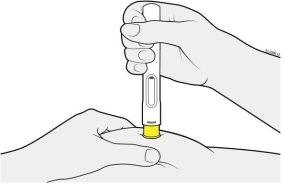
- Pinch the skin to create a firm surface at the injection site.
Place the yellow safety protector straight against the pinched skin.
- Keep the skin pinched until the injection is complete.
- Make sure you can see the window.
- Make sure the pre-filled pen is placed straight against the injection site (at a 90-degree angle).
PUSH AND HOLD
down to start the injection
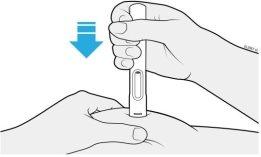
- Push the pre-filled pen firmly until the yellow safety protector stops moving.
Hold the pre-filled pen without lifting it.
- The needle will automatically insert and the injection will start.
- You may hear or feel a click.
- Keep the pre-filled pen straight and firm against the skin.
OBSERVE
the window will turn completely yellow
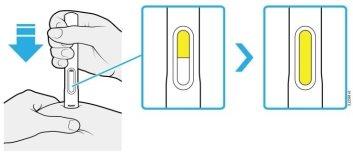
- Continue to push the pre-filled pen against the skin. Wait until the window turns completely yellow.
- The injection may take up to 15 seconds to complete. You may hear or feel a click.
- After the window turns completely yellow, lift the pre-filled pen from the skin.
Checking the Injection Site and Disposing of the Pre-filled Pen |
CONFIRM
The medication has not leaked (it does not matter if there is a small drop) |
| The window is completely yellow |
- Confirm that the full dose of the medication has been injected.
- Do nottouch the yellow safety protector.
- It does not matter if you see a small amount of liquid at the injection site.
Important:If the window has not changed completely to yellow, it appears that medication is still coming out, or you see several drops of medication, a full dose has not been injected. Call your healthcare professional immediately. |
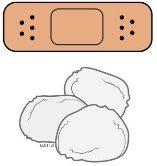
- Check the injection site.
- Do notrub the injection site.
- If there is bleeding, press on the injection site with a cotton ball or gauze.
- Apply a bandage if necessary.
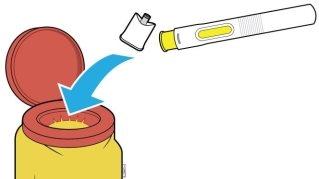
- Place the used pre-filled pen and cap in the sharps container.
Important:Do not throw the pre-filled pen in the trash |
- Do notreuse the pre-filled pen.
- Do nottouch the yellow safety protector.
You should dispose of any unused product left in the pre-filled pen. Medicines should not be disposed of via wastewater or household waste. Ask your pharmacist how to dispose of medicines no longer required. This will help protect the environment.
- Country of registration
- Active substance
- Prescription requiredYes
- Manufacturer
- This information is for reference only and does not constitute medical advice. Always consult a licensed doctor before taking any medication. Oladoctor is not responsible for medical decisions based on this content.
- Alternatives to WEZENLA 45 mg SOLUTION FOR INJECTION IN A PRE-FILLED PENDosage form: INJECTABLE PERFUSION, 130 mgActive substance: ustekinumabManufacturer: Accord Healthcare S.L.U.Prescription requiredDosage form: INJECTABLE, 45 mgActive substance: ustekinumabManufacturer: Accord Healthcare S.L.U.Prescription requiredDosage form: INJECTABLE, 90 mgActive substance: ustekinumabManufacturer: Accord Healthcare S.L.U.Prescription required
Online doctors for WEZENLA 45 mg SOLUTION FOR INJECTION IN A PRE-FILLED PEN
Discuss dosage, side effects, interactions, contraindications, and prescription renewal for WEZENLA 45 mg SOLUTION FOR INJECTION IN A PRE-FILLED PEN – subject to medical assessment and local rules.



